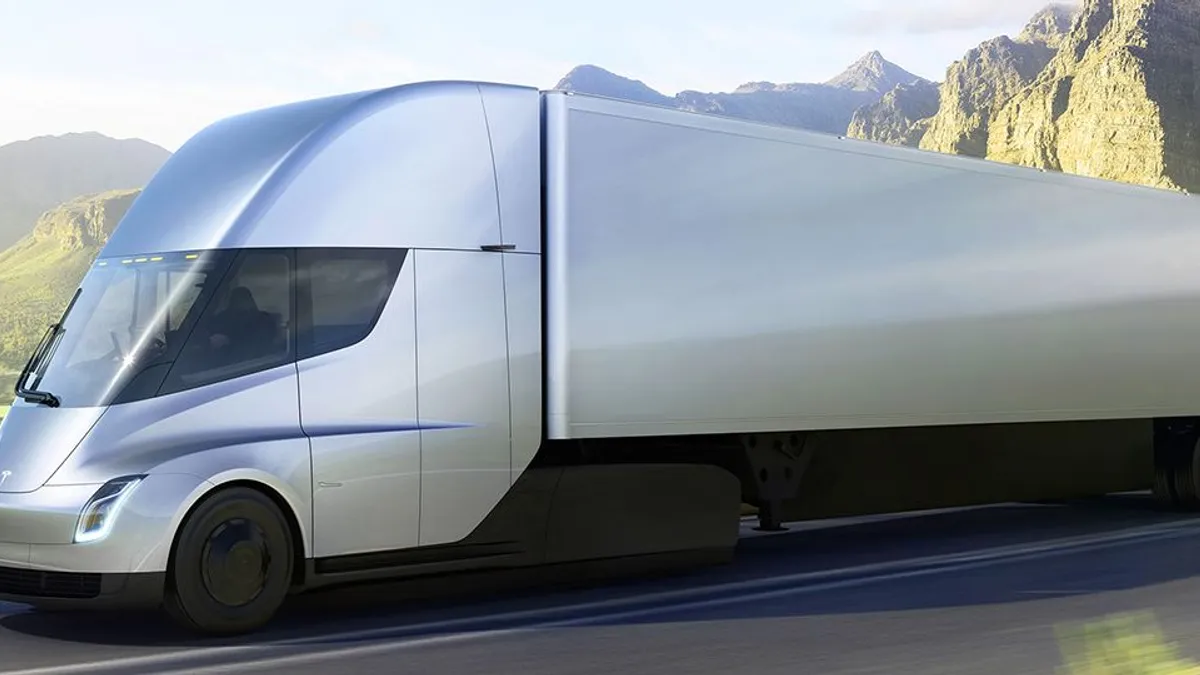Dive Brief:
- Tesla is pushing back the timeline for production of its battery-electric Semi, according to Tesla's earnings presentation. The vehicle's program is now planned to launch in 2022.
- The delay was prompted by increased prioritization of Model Y production, as well as "the limited availability of battery cells and global supply chain challenges," the presentation read. Tesla CEO Elon Musk also cited the semiconductor shortage during an earnings call Monday.
- The Semi program has been delayed multiple times, and Tesla has cited component constraints when announcing each postponement. The first delivery was originally planned for 2019.
Dive Insight:
The Tesla Semi has a range of up to 500 miles, according to the OEM — a relatively long range compared to other battery-electric, heavy-duty trucks in development. With that, Tesla touts the Semi can deliver $200,000 or more in fuel savings. But fleets eager to try out this option face a longer wait.
UPS is one of those customers. Thomas F. Jensen, senior vice president for transportation policy at UPS, said during a webinar that the carrier has the largest single pre-order for the Semi at 125. UPS' electric-vehicle strategy is to try out a range of options, he said.
"But that being said, you know, we are really waiting on the market in many instances," Jensen said.
Amazon Middle Mile Fleet Leader Tiffany Nida said on the same webinar her company was waiting on the truck market, too.
"We'd also love to make larger-scale purchases of electric heavy-duty trucks, but the technology and market for these heavy-duty vehicles is lagging behind," Nida said.
In some respects, Tesla is also waiting on markets. The battery market is one of them, as that supply chain works toward scaling to accomodate growing EV demand. Each Semi requires many cells, so if Tesla can't secure the capacity, ramping up manufacturing is "kind of pointless," Musk said.
Tesla could make a small batch of vehicles, but the cost per vehicle — which would be, at least in part, handed down to the customer — could reach over $1 million, Musk added.
"We are looking at a pretty massive increase in cell availability next year," he said, noting cell capacity will take time throughout the year to ramp up. But Musk said Tesla believes its suppliers can produce about twice as much cell output next year, compared to this year.
The semiconductor market is also currently lagging, as shortages slow truck production.
Factory fires, pandemic-related clogs in the supply chain and heightened demand have led to lower availability of semiconductors. Changes in OEM procurement habits contributed to an inventory shortage of chips, as well. Some manufacturers passed on their chip allocations last year as the coronavirus took hold, so those suppliers found buyers elsewhere.
"In order for Cybertruck and Semi to scale to volume that's meaningful for customer deliveries, we've got to solve the chip shortage ... working with our suppliers," Musk said.
For now, Tesla is prioritizing, and it appears the Semi did not land high on the list. The automaker plans to produce Cybertruck, Model Y, Model 3 and Semi in its Gigafactory near Austin, Texas, which is currently being built.















